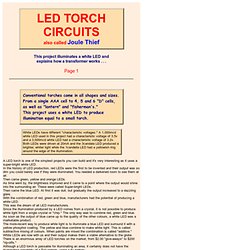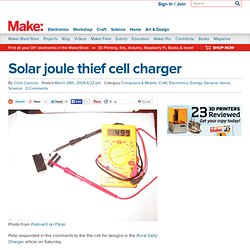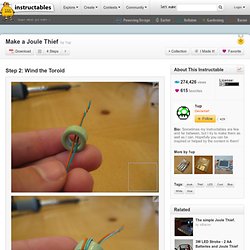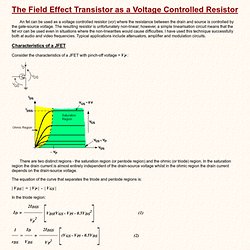

BC307/308/309 Switching and Amplifier Applications - BC30x.pdf. Online Circuit Simulator with SPICE.
Projects. 200 Transistor Circuits. This will clear-up a lot of mysteries of the solar panel.

Many solar panels produce 16v - 18v when lightly loaded, while other 12v solar panels will not charge a 12v battery. Some panels say "nominal voltage," some do not give any value other than 6v or 12v, and some specify the wrong voltage. You can't work with vague specifications. You need to know accurate details to charge a battery from a solar panel. TALKING ELECTRONICS LED Torch. A LED torch is one of the simplest projects you can build and it's very interesting as it uses a super-bright white LED.

In the history of LED production, red LEDs were the first to be invented and their output was so dim you could barely see if they were illuminated. You needed a darkened room to see them at all. Then came green, yellow and orange LEDs. MOSFET fall time too slow - Electrical Engineering - Stack Exchange. Concise electronics for geeks. Copyright (C) 2010 by Michal Zalewski <lcamtuf@coredump.cx> There are quite a few primers on electronics on the Internet; sadly, almost all of the top hits resort to gross oversimplifications (e.g., hydraulic analogies), or convenient omission, when covering subtle but incredibly important topics such as the real-world behavior of semiconductors.

There are some exceptions, to be sure - but they tend to suffer from another malady: regressions into mundane, academic rigor, complete with differential equations and complex number algebra in transient analysis - a trait that is highly unlikely to be accessible, or even useful, to hobbyists. The physics of conduction [link] As you probably recall from your school years, the dated but still useful Bohr model of the atom explains that atoms consist of a dense center (nucleus) with a variable number of protons and neutrons.
The strongly bound and heavy nuclei of stable isotopes do not undergo any structural changes under everyday circumstances. JeremyBlum.com. NerdKits. Solar Joule Thief. Photo from Petmar0 on Flickr Pete responded in the comments to the the call for designs in the Rural Celly Charger article on Saturday.

How about connecting a joule-thief circuit (DC-DC upconverter) to a cap on one side and a small solar cell (like the ones in calculators) on the other? You pull off of the cap to the cell phone directly. If I remember correctly, most cell phones have internal Vregs between the battery and the rest of the circuitry, so that takes care of your OV protection. I’ll see if I can build this, and then get back to you. Within a few hours on his busy Saturday, he had a rough build tested and posted up. Photo from petmar0 on Flickr The original article on Women of Uganda Network, or WOUGNET, told of how a Ugandan woman built her own charger after an unscrupulous vendor nicked her good battery and replaced it with a nearly dead one. Joule Thief. The first step is to wind the toroid.

I found mine in an old computer power supply, and it works fine for me. Toroids are donut-shaped objects like in the picture, and can be attracted by a magnet. You can find toroids in a few places. Old computer motherboards, XBOX and X360 motherboards have them (don't take them unless it's dead!). Joule Thief. 555 Square Wave Generator. This is a simple square waveoscillator using a 555 timer chip.

A timing interval starts when the trigger input ("tr") goes lower than 1/3 Vin, or 3.33V. When this happens, the 555 output goes high, and the 555 waits for the threshold input ("th") to reach 2/3 Vin, or 6.67V. As the capacitor charges, the threshold input slowly rises until it reaches the required level. Then, the timing interval ends, the output goes low, and the capacitor is discharged through the "dis" input. When the capacitor is discharged enough so that the trigger reaches 3.33V, then a new timing interval begins. 555 timer. 555 Timer Navigation Custom Search Learn about the 555 by building the DOCTRONICS Safety Lights Project: 1.

Pin connections. Current Mirror (with MOSFETs) - Circuit Simulator. Using a FET as a Voltage Controlled Resistor. An fet can be used as a voltage controlled resistor (vcr) where the resistance between the drain and source is controlled by the gate-source voltage.

The resulting resistor is unfortunately non-linear; however, a simple linearisation circuit means that the fet vcr can be used even in situations where the non-linearities would cause difficulties. I have used this technique successfully both at audio and video frequencies. Typical applications include attenuators, amplifier and modulation circuits. Consider the characteristics of a JFET with pinch-off voltage = VP : There are two distinct regions - the saturation region (or pentode region) and the ohmic (or triode) region. Sample-and-Hold - Circuit Simulator. Open source electronic projects. Soft Latching Power Switch Circuit. Schmitt trigger provides toggle function - 2011-03-17 10. CircuitLab.
Free Online Schematic Drawing Tool.